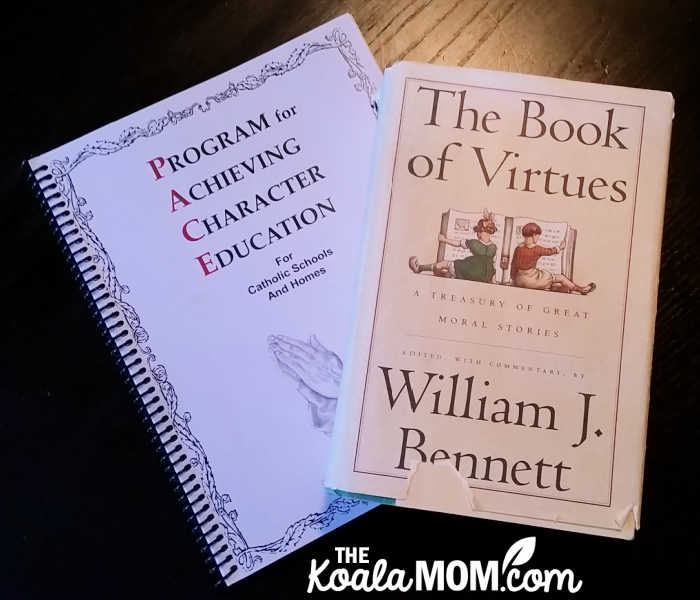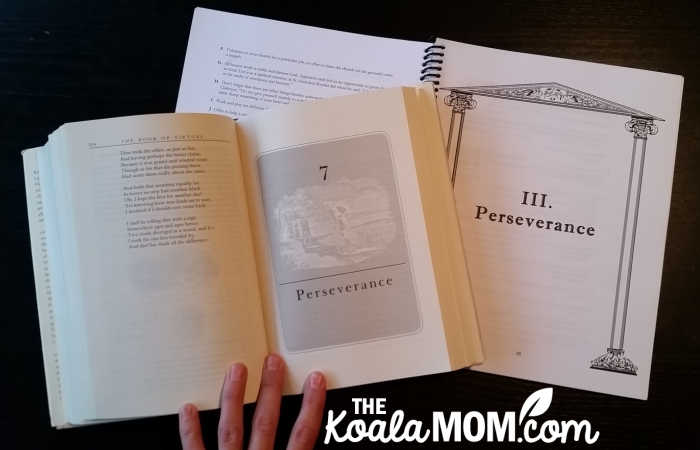So much of our children’s daily education time goes into easy-to-teach and easy-to-assess skills such as reading, writing and math. We fill their brains with facts and figures, definitions and rules, dates and details. We want them to have a well-rounded education, to know about their world and its history, to read well, to add and subtract. And yet there’s a big area of education that we might be overlooking… their character. How do we teach children character qualities such as self-discipline, perseverance, responsibility, and honesty? These qualities, in many ways, may be more important than reading and writing, and will help our children learn reading and writing and so many other skills!

I received this program for review courtesy of the publisher; all opinions expressed are my own. This post contains affiliate links; as an Amazon associate, I earn from qualifying purchases.
Program for Achieving Character Education for Catholic Schools and Homes by Monica Speach is an in-depth curriculum that helps parents (and teachers) instill strong character in their children. Based upon William J. Bennett’s classic Book of Virtues, PACE covers self-discipline, work, perseverance, faith and trust, compassion, friendship, courage, loyalty, responsibility, honest, and prayers. These are all characters that I want my children to possess, yet they are also intangible qualities that are hard to teach and don’t fit any of the curriculum outcomes we’re expected to meet as homeschoolers.
Our children are not being taught how to be responsible citizens. While the Department of Education pours an enormous amount of money into trying to educate our youth, they neglect the moral component of education. As President Theodore Roosevelt once said, “To educate a person in the mind but not in morals is to educate a menace to society.” ~ Monica Speach
I first heard about PACE from a friend of mine who was exploring the option of homeschooling and looking for solid Catholic curriculum for her kids. As I checked out Monica’s program, I was absolutely blown away. PACE offers parents (and teachers) a comprehensive, easy-to-use, practical method of teaching character. Based on short, interesting stories, this program invites children to internalize and think about each character quality and how they can apply it to their own lives.
An Overview of PACE
As mentioned, PACE focuses on ten characters or virtues, plus a unit on prayers. These ten characters are the same by which The Book of Virtues is organized; thus, The Book of Virtues is like a textbook, with PACE as the teacher’s manual, helping parents to draw out the lessons conveyed in the stories compiled by William J. Bennett. There is both a Catholic manual and a Christian manual available, as well as corresponding workbooks for the Catholic manual.
Monica Speach organizes the study of each virtue into ten areas:
- quotations from famous people, Scriptures, or saints
- a definition of the virtue or character quality, with adjectives, synonyms and antonyms
- stories (from The Book of Virtues and The Moral Compass, organized by grade level)
- Bible passages
- Mary & the saints OR heroes (saints / heroes who were exemplars of this virtue or struggled with it)
- recommended books (organized by grade level again)
- discussion topics (which could also be used as writing prompts)
- writing assignments
- enrichment activities, such as music, art, and nature
- how to practice this activity (specific, actionable ideas and examples)
How to Use PACE
I’ve been using the Catholic manual for PACE. I asked my mom if I could borrow our childhood copy of The Book of Virtues, which she once upon a time read aloud to my brothers and I. The recommended books I’ve either found in our local library or on YouTube (it’s amazing how many read-aloud stories you can find there!). PACE has fit into our homeschool day as a sort of “morning basket” activity.
I grab The Book of Virtues, a Bible, a few saint stories (from one of our many saint books), and possibly another book to read with the kids. The quotes for each unit provide great copy work or dictation assignments for the girls. Other parts of the program overlap with other elements of their curriculum; for example, reading and writing help meet language arts outcomes, enrichment activities meet fine arts outcomes, and practical applications of the virtue can meet all sorts of outcomes from physical education to art to career education.
For a more in-depth study of each character quality, you can use the workbooks. Each workbook corresponds to a specific grade level, from K to 6th grade. These workbooks make PACE into an open-and-go curriculum. The easy-to-follow format features more than 130 pages of engaging activities and lessons for each day of the week. With clear instructions and supporting illustrations for the dependent reader, this PACE workbook makes learning easy and fun!
The workbooks are laid out by week and day of the week. It is designed for 5 days a week and takes a very short amount of time to complete. The K work can be completed in 5 minutes or less, the 3rd work in about 10-15 minutes, depending on how comfortable your child is with certain activities. Anything requiring writing takes my 3rd grader longer ;). And the Friday enrichment activities can take as long as you let them. ~ Jen, Happy Little Homemaker
My Thoughts on PACE
I’ll admit that as a homeschool mom, it’s daunting to think of adding something “more” to our homeschool curriculum. This year, I’ve tried to focus on covering the core subjects for each of my kids and making sure that we are ticking the boxes (and meeting the teacher’s expectations). Sometimes, at the end of the day, I’m exhausted and one or more child hasn’t yet completed their reading assignment or typing practice for the day.
Adding some components of character education to your homeschool doesn’t need to be a huge endeavor. For example, my girls love it when I read aloud to them (and Jade’s reading curriculum actually encourages at least 20 minutes of read-aloud time every day!). Calling them to sit down and read a story together is a great way to start our day. As I mentioned, many of the activities in this program are cross-curricular and can be used to meet other educational outcomes. In fact, PACE could be used as your religion / language arts program wrapped into one.
Another aspect that drew me to this program is the multi-age component. This year, I’m teaching four girls in grades K/1 to 7. Instead of teaching them each separately, I try to group them. Sunshine and Lily (grades 6 and 7) do some of their work together, and Jade and Pearl (grades K/1 and 2) do a lot of projects together. PACE lets me teach each of them the same character, while adpting it to their age level. For example, we can all read a Bible passage and saint story and discuss it; then Pearl and Jade can copy a quote while Lily and Sunshine work on a longer writing assignment or do some independent reading related to the character.
More about PACE
Visit the PACE website for more about Monica Speach’s amazing program, as well as extra resources.
If you have kids in junior high, you may want to check out CLASP (Character Education Language Arts Supplement for PACE), which turns PACE into a complete language arts curriculum for your grade 6 – 9 student.
If your children (like so many today) are into heroes, take a look at RAHBAH (Read a Hero, Be a Hero), a stand-alone workbook that features 50 original biographies of heroes from around the world and encourages kids to reflect on heroism and what it means.
You can also find free resources on the website, including two booklists and three free lesson plans.
When I chatted with my daughters’ teachers at the beginning of this year, I realized that my goals for them for the year weren’t academic as much as personal. I’m not worried about where they are at with their reading and writing. Instead, I want Jade to learn perseverance and work (as she gives up too easily when things get tough). I want Sunshine to improve in responsibility and self-motivation (as she too-often asks me, “Do I have to do this? Can’t I just do part of it?). These are areas of growth that aren’t taught in our regular curriculum, yet they will be much more useful to my daughters over the course of their life than knowing about Newton’s laws of motion or what a prepositional phrase is. And that’s what PACE offers our children.
Expected outcomes from PACE include:
- consistent character-enhancing messages which produce more consistent behaviors
- improved academic performance
- developed trust among students through sharing and discussion
- more knowledge and background to help students make sound decisions when faced with a moral dilemma
- student self-improvement
- learning of positive values through age-old, tried and test stories and books
- abstract concepts become more concrete through reading, writing and discussion
- development of character behaviors that encourage growth as a responsible citizen.
More about Monica Speach
Monica has a Master of Arts degree in Education and has worked with kids from kindergarten to college. She has taught ESL and Spanish and homeschooled her own children for eleven years. Recently, her work has centered on issues of civic responsibility, volunteerism and character education. The PACE curriculum is a direct result of her research and ongoing interest in the growing field of character education. You can follow her on Instagram for tips and updates about her program.
How do you teach your children character qualities and virtues such as honesty, self-discipline, and loyalty?


No Responses Yet